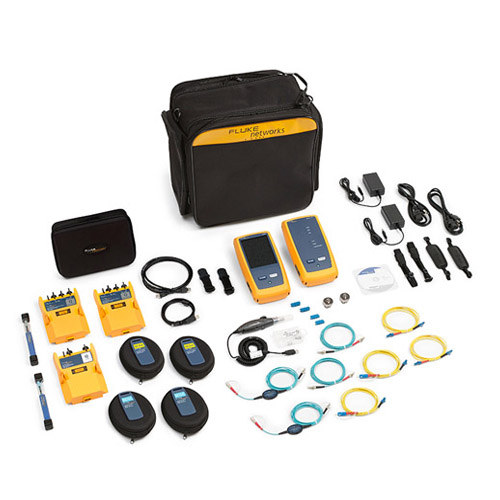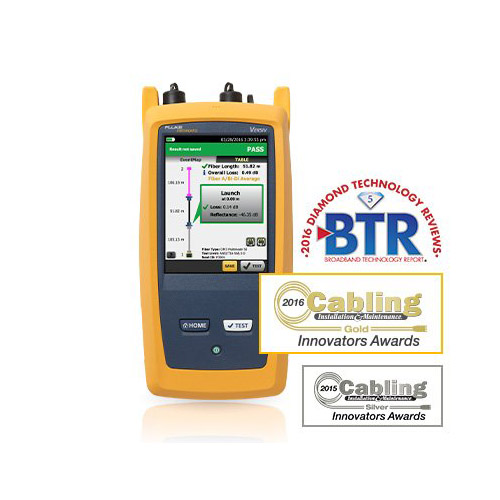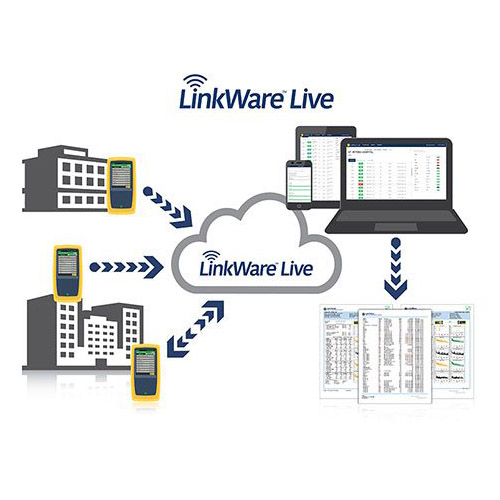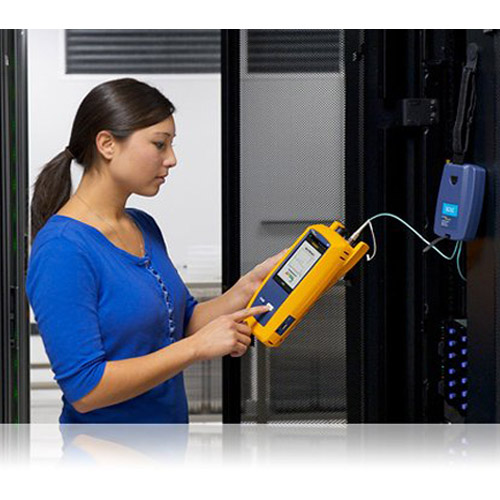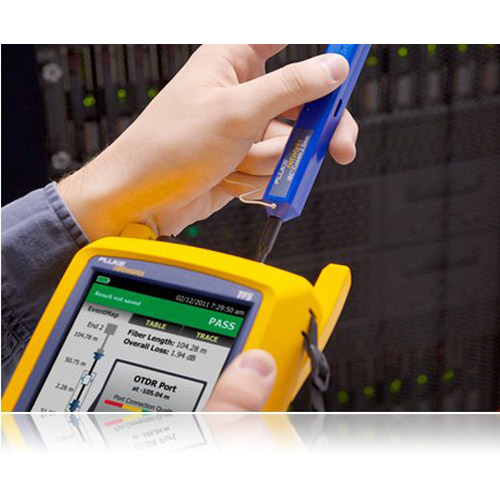Description
OptiFiber® Pro OTDR
Built for the Enterprise
OptiFiber Pro is the first OTDR built from the ground up for enterprise fiber optic cabling testing. OptiFiber Pro is focused on reducing costs while enhancing productivity and improving network reliability.
- First OTDR with a smartphone user-interface
- Industry’s shortest event and attenuation dead zones
- Accelerate fiber certification with the fastest set-up and trace times
- SmartLoop™ technology enables the testing of two fibers in a single test eliminating the need to travel to the far end of the connection to perform tests.
- Versiv™ modular design supports copper certification, fiber optic loss, OTDR testing and fiber end-face inspection
- Instantaneous bi-directional averaging results included at no charge
- Improve resource utilization with custom configurations for projects and users
- Simplify use with “DataCenter OTDR™” mode and EventMap™ view
- Compatible with Linkware™ Live. Linkware Live enables to easily track job progress, get real-time access to test results to quickly fix problems in the field, and easily transfer and consolidate test results from the tester to LinkWare™ PC Cable Test Management Software.
Features
- Smartphone User Interface
- Most OTDRs are designed for a myriad of applications, causing the user interface to be difficult to navigate and interpret. OptiFiber Pro combines the latest “gesture-based” interface technology with a capacitive touchscreen to deliver the most innovative and user-friendly OTDR.Advantages:
- Single-touch tap and swipe control for selecting and scrolling menu items
- Multi-touch pinch to zoom for easy magnification control on a graphical fiber trace
- Task-focused design to reduce back and forth navigation through screens
- Capacitive touchscreen eliminates the need to recalibrate unlike legacy touchscreens
- Context sensitive on-screen help that gives users additional details or problem resolution suggestions

- Optimized for the Datacenter
- Driven by server virtualization and multi-gigabit links between servers, networks and storage, the datacenter architecture employs more patch cords and dense topology connectors, rendering carrier-class OTDRs with long dead zones ineffective. OptiFiber Pro not only makes fiber deployment in datacenters possible, but provides the highest level of accuracy for quick problem resolution.With a simple one-touch selection, users enter DataCenter OTDR mode – without setup time for fine-tuning as needed in legacy OTDRs. DataCenter OTDR mode automatically detects OTDR parameters – end-detection algorithms, pulse widths, etc – without getting confused by the short links or number of connectors.Advantages:
- Ultra-short event and attenuation dead-zones precisely locates events and faults on fiber links
- DataCenter OTDR™ mode automatically sets the configuration to quickly test datacenter fiber
- The EventMap feature depicts fiber events in a way that requires no trace analysis expertise

- SmartLoop OTDR
- SmartLoop OTDR enables automated testing and analysis of two fibers in a single test while meeting standard’s requirements. This patent pending process automatically separates the two fibers for individual pass/fail analysis, display, and reporting. Not only does this cut the testing time by at least half, it also enables instant bi-directional averaged test results without moving the OTDR to the far end. In addition to getting the job done quicker, SmartLoop OTDR further enhances the ease and speed of testing in environments where the far end is difficult of even dangerous to reach because the OTDR never has to be moved to the far end. In addition to getting the job done quicker, SmartLoop meets the standard’s requirements of leaving the launch and tail fibers in their initial locations during both bi-directional tests.
- Test it right and test it fast with SmartLoop – included for free in all OptiFiber Pro modules.
- Unique Certification with Flexibility and Efficiency
An important aspect in maximizing an OTDR’s value is to properly plan its day-to-day usage. With built-in project management, OptiFiber Pro allows a project manager to define each user’s role, settings and the associated tasks to be performed – transforming the OTDR into an all-in-one fiber testing tool complete with planning, inspection, certification and reporting.
OptiFiber Pro enhances job efficiency by allowing the workflow planner to create and manage operator and job profiles per project – defined jobs or sets of cable IDs can be assigned to specific operators. The progress and status of each project can also be easily monitored.
Advantages:
- Full OTDR capability that certifies fiber performance based on job assignment for each operator
- Powerful project management facilitates OTDR sharing with clear job assignment for each operator
- Easy monitoring of job progress with pass/fail results
- On-screen report generation and upload to LinkWare™ application

- Fiber Endface Inspection and Certification
OptiFiber Pro incorporates the FiberInspector Pro video inspection system which enables you to quickly inspect and certify fiber end-faces inside ports or patch cords. It’s 1-second automated PASS/FAIL certification, per IEC 61300-3-35, eliminates human subjectivity and enables anyone to become a fiber inspection expert. Results can be saved in the certification report alongside OptiFiber Pro’s OTDR results.

- Other Key Features
Extremely short event and attenuation dead zone
The OptiFiber Pro leverages the most sophisticated optical technology to provide the shortest event dead zone (0.5 m typical for MM) and attenuation dead zone (2.2 m typical for MM and 3.6 m typical for SM) of any OTDR. This technological advancement allows OptiFiber Pro to detect and measure closely spaced faults where no other OTDR can in today’s connector-rich datacenter and storage area environments.

LinkWare™ management software
Leveraging the popular and multi-featured LinkWare cable test management software application, OptiFiber Pro users can easily access the hassle-free project management, report generation, and software upgrade capabilities to manage workflow and consolidate test results.

Two second trace per wavelength
Another breakthrough with OptiFiber Pro is the data acquisition speed. While in Quick Test mode, a complete set of data is acquired in as little as two seconds per wavelength. OptiFiber Pro then analyzes the data and displays it as an EventMap, Table or Trace. The end result is less time spent testing and more time performing other tasks.

On-screen help – corrective action
On-screen “help” suggests corrective action(s) for resolving fiber problems during each testing step. The “help” offered is context sensitive which allows users to quickly pinpoint possible resolutions. An easy-to-read, gray icon in the bottom, left-hand corner shows detailed corrective action recommendations.

- LinkWare™ Live Test Results Management Service
Specifications
Key OTDR specifications
| Multimode module | Singlemode module | Quad module | |
| Wavelengths | 850 nm +/- 10 nm 1300 nm +35/-15 nm |
1310 nm +/- 25 nm 1550 nm +/- 30 nm |
850 nm +/- 10 nm 1300 nm +35/-15 nm 1310 nm +/- 25 nm 1550 nm +/- 30 nm |
| Compatible fiber types | 50/125 µm 62.5/125 µm |
Singlemode | 50/125 µm 62.5/125 µm Singlemode |
| Event dead zone 1 | 850 nm: 0.5 m typical 1300 nm: 0.7 m typical |
1310 nm: 0.6 m typical 1550 nm: 0.6 m typical |
850 nm: 0.5 m typical 1300 nm: 0.7 m typical 1310 nm: 0.6 m typical 1550 nm: 0.6 m typical |
| Attenuation dead zone 2 | 850 nm: 2.5 m typical 1300 nm: 4.5 m typical |
1310 nm: 3.6 m typical 1550 nm: 3.7 m typical |
850 nm: 2.5 m typical 1300 nm: 4.5 m typical 1310 nm: 3.6 m typical 1550 nm: 3.7 m typical |
| Dynamic range 3, 5, 6 | 850 nm: 28 dB typical 1300 nm: 30 dB typical |
1310 nm: 32 dB typical 1550 nm: 30 dB typical |
850 nm: 28 dB typical 1300 nm: 30 dB typical 1310 nm: 32 dB typical 1550 nm: 30 dB typical |
| Max distance range setting | 40 km | 130 km | MM: 40 km SM: 130 km |
| Distance measurement range 4, 5, 7, 8, 9, 10 | 850 nm: 9 km 1300 nm: 35 km |
1310 nm: 80 km 1550 nm: 130 km |
850 nm: 9 km 1300 nm: 35 km 1310 nm: 80 km 1550 nm: 130 km |
| Reflectance range 4, 5 | 850 nm: -14 dB to -57 dB (typical) 1300 nm: -14 dB to -62 dB (typical) |
1310 nm: -14 dB to -65 dB (typical) 1550 nm: -14 dB to -65 dB (typical) |
850 nm: -14 dB to -57 dB (typical) 1300 nm: -14 dB to -62 dB (typical) 1310 nm: -14 dB to -65dB (typical) 1550 nm: -14 dB to -65 dB (typical) |
| Sample resolution | 3 cm to 400 cm | 3 cm to 400 cm | 3 cm to 400 cm |
| Pulse widths (nominal) | 850 nm: 3, 5, 20, 40, 200 ns 1300 nm: 3, 5, 20, 40, 200, 1000 ns |
1310/1550 nm: 3, 10, 30, 100, 300, 1000, 3000, 10000, 20000 ns | 850 nm: 3, 5, 20, 40, 200 ns 1300 nm: 3, 5, 20, 40, 200, 1000 ns 1310/1550 nm: 3, 10, 30, 100, 300, 1000, 3000, 10000, 20000 ns |
| Test time (per wavelength) | Auto setting: 5 sec (typical) | Auto setting: 10 sec (typical) | Auto setting: MM – 5 sec (typical) SM – 10 sec (typical) |
| Quick test setting: 2 sec (typical) |
Quick test setting: 5 sec (typical) |
Quick test setting: MM – 2 sec (typical) SM – 5 sec (typical) |
|
| Best resolution setting: 2 to 180 sec |
Best resolution setting: 5 to 180 sec |
Best resolution setting: MM – 2 to 180 sec M SM – 5 to 180 sec |
|
| FaultMap setting: 2 sec (typical), 180 sec (max) |
FaultMap setting: 10 sec (typical), 180 sec (max) |
FaultMap setting: MM – 2 sec (typical), MM – 180 sec (max) SM – 10 sec (typical), SM – 180 sec (max) |
|
| DataCenter OTDR setting: 1 sec (typical at 850 nm), 7 sec (max) |
DataCenter OTDR setting: 20 sec (typical), 40 sec (max) |
DataCenter OTDR setting: MM – 1 sec (typical at 850 nm) MM – 7 sec (max) SM – 20 sec (typical) SM – 40 sec (max) |
|
| Manual setting: 3, 5, 10, 20, 40, 60, 90, 120, 180 sec |
Manual setting: 3, 5, 10, 20, 40, 60, 90, 120, 180 sec |
Manual setting: -3, 5, 10, 20, 40, 60, 90, 120, 180 sec SM – 3, 5, 10, 20, 40, 60, 90, 120, 180 sec |
- Measured at 1.5 dB below non-saturating reflection peak with the shortest pulse width. Reflection peak < -40 dB for multimode and < – 50 dB for singlemode.
- Measured at +/- 0.5 dB deviation from backscatter with the shortest pulse width. Reflection peak < -40 dB for multimode and < – 50 dB for singlemode.
- For typical backscatter coefficient for OM1 fiber: 850: -65 dB, 1300: -72 dB.
- Typical backscatter and attenuation coefficients for OM2-OM4 fiber: 850 nm: -68 dB; 2.3 dB/km: 1300 nm: -76 dB; 0.6 dB/km.
- Typical backscatter and attenuation coefficients for OS1-OS2 fiber: 1310nm : -79 dB; 0.32 dB/km; 1550 nm: -82 dB; 0.19 dB/km.
- SNR=1 method, 3 minute averaging, widest pulse width.
- 850 = 9 km typical to find the end or 7 km typical to find a 0.1 dB event (with a maximum of 18 dB attenuation prior to the event).
- 1300 = 35 km typical to find the end or 30 km typical to find a 0.1 dB event (with a maximum of 18 dB attenuation prior to the event).
- 1310 = 80 km typical to find the end or 60km typical to find a 0.1 dB event (with a maximum of 20 dB attenuation prior to the event).
- 1550 = 130 km typical to find the end or 90 km typical to find a 0.1 dB event (with a maximum of 18 dB attenuation prior to the event).
- Does not include index of refraction error and does not include automatic event location error.
- dB variation per 1 dB step.
- Applies along the trace backscatter within the distance range in which the OTDR can find a 0.1 dB event.
Additional key specifications
| FiberInspector probe specification | |
| Magnification | ~ 200X with OptiFiber Pro Display |
| Light source | Blue LED |
| Power source | Versiv mainframe |
| Field of View (FOV) | Horizontal: 425 µm Vertical: 320 µm |
| Minimum detectable particle size | 0.5 µm |
| Dimensions | Approximately 6.75 in x 1.5 in (1175 mm x 35 mm) without adapter tip |
| Weight | 200 g |
| Temperature range | Operating: 32°F to 122°F (0 °C to +50 °C) Storage: -4°F to +158°F (-20°C to +70°C) |
| Certifications | CE (when used with the mainframe) |
| VFL specifications | |
| On/Off control | Mechanical switch and a button on the touch screen |
| Output power | 316 µW (-5 dBm) = peak power = 1.0 mW (0 dBm) |
| Operating wavelength | 650 nm nominal |
| Spectral width (RMS) | ±3 nm |
| Output modes | Continuous wave Pulsed mode (2 Hz to 3 Hz blink frequency) |
| Connector adapter | 2.5 mm universal |
| Laser safety (classification) | Class II CDRH Complies to EN 60825-2 |
| General specifications | |
| Weight | Mainframe with module and battery: 3 lbs, 5 oz (1.28 kg) |
| Dimensions | Mainframe with module and battery: 2.625 in x 5.25 in x 11.0 in ( 6.67 cm x 13.33 cm x 27.94 cm) |
| Battery | Lithium ion battery pack, 7.2 volts |
| Battery life | Eight hour Auto OTDR operation, dual wavelength, no video probe connected, 150 m of fiber |
| Charge Time | |
| Tester Off | Four hours to charge from 10% to 90% capacity |
| Tester On | Six hours to charge from 10% to 90% capacity with the tester on |
| Environmental specifications | |
| Operating temperature* | -10ºC to 45ºC |
| Storage Temperature | -10ºC to +60ºC |
| Operating altitude | 4,000 m (13123 ft) 3200 m (10,500 ft) with ac adapter |
| Storage altitude | 12,000 m |
| EMC | EN 61326-1 |
* Using battery power. With AC power: 0ºC to 45ºC. Real Time Trace function used for no more than 5 minutes in a 15-minute period. Maximum ambient temperature is 35ºC for continuous use of the Real Time Trace function.
* Do not keep battery at temperatures below -20°C (-4°F) or above 50°C (122°F) for periods longer than one week to maintain battery capacity.
OptiFiber Pro Quad OTDR and CertiFiber Pro Quad kit with inspection kit. This kit includes (1) Versiv Mainframe & Remote, (1) OptiFiber Pro Quad OTDR module, (2) CertiFiber Pro Quad OLTS modules, (2) HandStraps, (2) Shoulder Straps, (2) Carry Cases, USB Interface Cable, Versiv Open Source Software CD, (2) AC Chargers, (2) Quick Clean Cleaners (1.25/2.50 mm), (2) SC/LC Multimode Launch Cables—50 µm, (2) SC/LC Singlemode Launch Cables—9 µm, (2) OTDR source port interchangeable LC adapters, USB Fiber Inspection Video Probe with 4 Tips, SC/SC Simplex Adaptor, (2) LC/LC Simplex Adaptor, SC/LC EF-compliant MM TRC Kit 50 µm, TRC Carry Case, (2) Launch Fiber Hanging straps and magnets, Statement of Calibration and Getting Started Guides.





